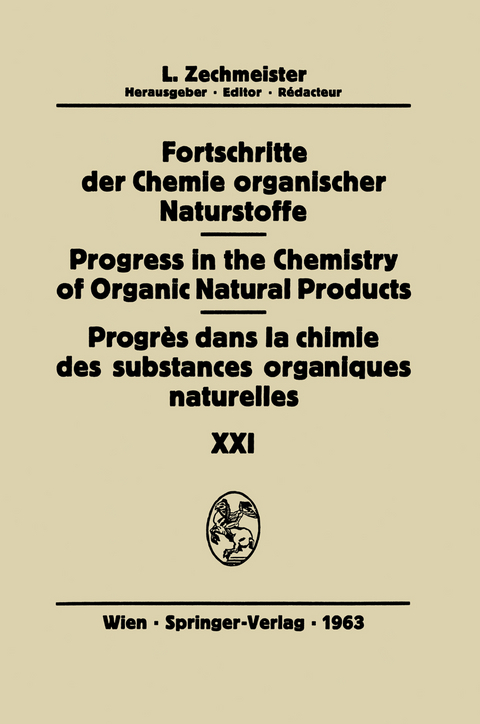
Progrès Dans La Chimie Des Substances Organiques Naturelles/Progress in the Chemistry of Organic Natural Products
Springer Wien (Verlag)
978-3-7091-7150-9 (ISBN)
The Biosynthesis of Rubber.- I. Distribution of Rubber.- II. Latex.- III. Biogenesis of the Monomer.- IV. Polymerization.- V. Further Problems.- References.- The Polyene Antifungal Antibiotics.- I. Introduction.- II. Ultraviolet Spectra.- III. Structural Elucidation.- IV. Biogenetic Relationships.- V. Tables.- References.- Die Chemie der Tetracycline.- I. Einleitung.- II. Konstitutionsaufklärung.- III. Weitere chemische Eigenschaften.- IV. Biogenese der Tetracycline.- V. Versuche zur Synthese von Tetracyclinen.- Anthracyclinone und Anthracycline (Rhodomycinone, Pyrromycinone und ihre Glykoside)..- I. Einleitung.- II. Isolierung der Anthracyclinone und Anthracycline.- III. Die Anthracyclinone.- IV. Die Anthracycline.- Folsäure und Folat-Enzyme..- I. Einleitung.- II. Das Vitamin Folsäure.- III. Auf- und Abbau der Folsäure-Cofaktoren.- IV. Chemie der Folat-Verbindungen.- V. Das Einkohlenstoff-Reservoir.- VI. Folat-katalysierte Enzym-Reaktionen.- VII. Zusammenfassung.- Chemistry of the Natural Rotenoids..- I. Introduction.- II. General Remarks on Rotenone and the Rotenoids.- III. Stereochemistry of Rotenone.- IV. Chemistry of Rotenone.- V. The Rotenolones and Isorotenolones.- VI. The Rotenoids.- VII. Biogenesis and Biogenetic Connections of the Rotenoids.- VIII. Synthesis in the Rotenoid Group.- Addendum.- References.- Namenverzeichnis. Index of Names. Index des Auteurs.- Sachverzeichnis. Index of Subjects. Index des Matières.
| Erscheint lt. Verlag | 5.11.2011 |
|---|---|
| Reihe/Serie | Fortschritte der Chemie organischer Naturstoffe Progress in the Chemistry of Organic Natural Products |
| Co-Autor | R. Bangert, J. Bonner, H. Brockmann, L. Crombie, L. Jaenicke, C. Kutzbach, A.D. Mebane, H. Muxfeldt, W. Oroshnik |
| Zusatzinfo | VIII, 364 S. 2 Abb. |
| Verlagsort | Vienna |
| Sprache | deutsch |
| Maße | 152 x 229 mm |
| Gewicht | 543 g |
| Themenwelt | Naturwissenschaften ► Chemie ► Organische Chemie |
| Schlagworte | Chemie • Forschung • Naturprodukte • Naturstoff |
| ISBN-10 | 3-7091-7150-4 / 3709171504 |
| ISBN-13 | 978-3-7091-7150-9 / 9783709171509 |
| Zustand | Neuware |
| Haben Sie eine Frage zum Produkt? |
aus dem Bereich


